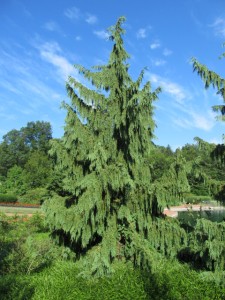Over the past decade, gardeners have been planting different evergreen trees in their Southern Appalachian landscapes (USDA zones 6 and 7). One of the newbies is Alaska cedar (Chamaecyparis nootkatensis), a wonderful medium-sized evergreen tree from the west coast of North America.
Alaska cedar matures into a graceful pyramidal tree form. Long pendulous flattened sprays of bluish green needles drape from the mostly horizontal branches. Needles turn grayish green in winter. Tall (40-50 feet) and narrow (15-25 feet) in stature, Alaska cedar is long-lived and a slow grower until established. It grows best in full to partial sunlight (6 hours minimum) in a compost rich, well-drained soil. A newly planted tree benefits from weekly irrigation over a hot, dry summer until fully established in three years.
Dense evergreen foliage conceals the reddish brown shredding bark within. Bark on an older trunk and branches appears ragged and gray colored. Flowers and ½- inch diameter seed cones are insignificant and require little cleanup. Alaska cedar has no serious disease or pest problems.
There are over 15 selections of Alaska cedar in nursery commerce. ‘Pendula’ (more weeping form), ‘Green Arrow’ (narrow) and ‘Van den Akker’(very narrow) are popular cultivars. Plant any one of these fabulous Alaska cedar cultivars nearby a deck or patio where it likely will become a major focal point in your landscape.
Alaska cedar has recently been reclassified as Cupressus nootkatensis.


 Posted in
Posted in 
